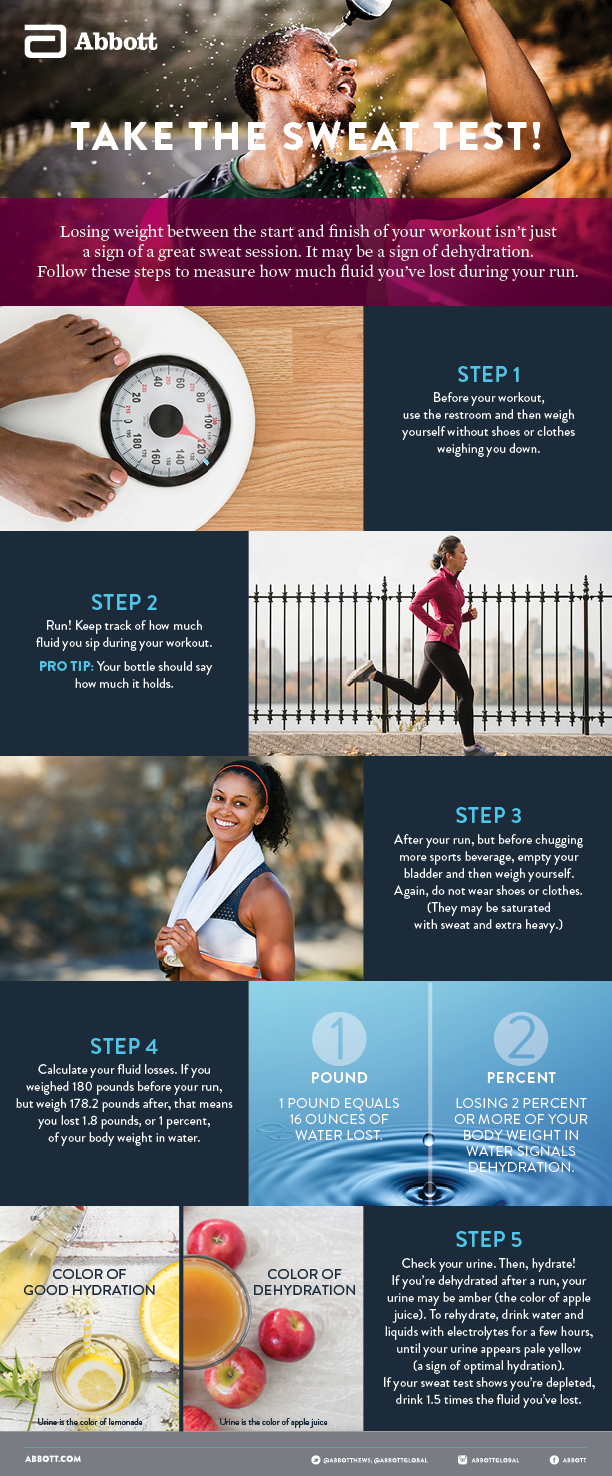
What Are Electrolytes?
Sodium, potassium and other electrolytes can optimize your hydration plan for healthier, stronger running performances.
Sodium, potassium and other electrolytes can optimize your hydration plan for healthier, stronger running performances.
June 25, 2019
- Copy Link
- Share on X
- Share on Facebook
- Share on Linkedin
Most runners know that they need electrolytes, but many aren’t exactly sure what those electrolytes are – or the best ways to get them.
Electrolytes are electrically charged minerals that help your body absorb and use the fluids you consume, as well as promote healthy nerve and muscle function, explains Pam Nisevich Bede, RD, MS, a board-certified sports dietitian and a manager of Medical Affairs in Abbott’s nutrition business. In many ways, they are what keeps runners… running. But runners also sweat them out.
“During exercise, sodium, chloride, and then potassium are lost in the greatest quantities, making them top electrolytes of concern,” she says. As levels of these electrolytes decrease during the course of a sweaty run, muscle function can decrease and the body can have difficulty effectively absorbing fluids. Dehydration reduces performance, can cause fatigue and headaches and, in extreme cases, lead to heat stroke.
Sodium chloride, also known as salt, influences fluid regulation and allows for proper cell signaling. While the average person’s day-to-day salt intake is more than high enough without factoring in exercise, sub-par levels can and do frequently occur during workouts performed in the heat or for durations longer than an hour, she says. Sports drinks and low-calorie electrolyte-containing hydration beverages are great sources, while whole foods including celery, whole-grain breads and broth-based soups that deliver many beneficial nutrients in addition to sodium, Nisevich Bede says.
Meanwhile, potassium works in conjunction with sodium with the end-goal of balancing fluids, cell activity and blood pressure. Bananas are a common race-day source, but she notes that tomatoes, dried fruit, melons, potatoes, milk, coconut water and avocado are also rich in the electrolyte.
The last two electrolytes, calcium and magnesium – both of which assist in muscle contraction and nerve transmission – are lost in much smaller quantities through sweat. And fortunately, you can also find them in electrolyte-containing beverages as well as other sodium chloride- and potassium-containing foods such as salted almonds. So, if during and after a run, you work to replace sodium chloride and potassium, you can run confident that your other electrolyte levels are on track as well.

Are You Getting the Electrolytes You Need?
“Electrolytes and fluids are going to go hand in hand during any run,” Nisevich Bede says. “Runs that last more than 60 minutes or performed in hot or intense conditions require not only fluids, but also electrolytes, throughout the workout.”
However, exact hydration requirements are unique to every runner. And while thirst is a good indicator in many people, very young and masters athletes often need to consume more fluid and electrolytes than their thirst levels suggest. Also, highly trained individuals often begin sweating earlier into their workouts, as their bodies’ cooling systems are primed to spring into action, meaning they may also benefit from increased fluid and electrolyte replacement.
No matter your age or training status, though, the sweat test can provide a very accurate measure of your overall fluid and electrolyte losses. To perform the sweat test, simply weigh yourself before and after exercising. Ideally, do this after having emptied your bladder and without shoes or clothes on to obtain the most accurate measurement possible.
The goal is to have lost no more than 1 percent of your body weight during the course of your workout. (If you weigh 180 pounds, that equals 1.8 pounds.) Once fluid losses reach 2 percent (or 3.6 pounds, for the same individual), dehydration has already set in and it’s important to replenish all lost fluids and electrolytes within a couple of hours.
Every pound lost between the beginning and end of your run represents 16 ounces of water – gone. So, after your workouts, drink at least 16 ounces of a low- or zero-calorie electrolyte-containing beverage (with an extra ounce or two as a buffer) for every pound lost during your workouts, she says.
If you step on the scale not just lighter than usual, but also with your skin feeling gritty, it’s a sign that you have lost a relatively high amount of electrolytes (especially sodium chloride, which has a “salty” feel), and you should prioritize rehydrating with electrolytes – and potentially planning to consume more through sports drinks, chews or tabs during your next running workout.
Download this infographic for hydration tracking tips.

Abbott is the title sponsor of the Abbott World Marathon Majors, a series of six of the largest and most renowned marathons in the world: Tokyo Marathon, Boston Marathon, Virgin Money London Marathon, BMW BERLIN-MARATHON, Bank of America Chicago Marathon and TCS New York City Marathon. Click here to learn more.
For the latest on Abbott’s life-changing technology, get updates directly in your inbox.